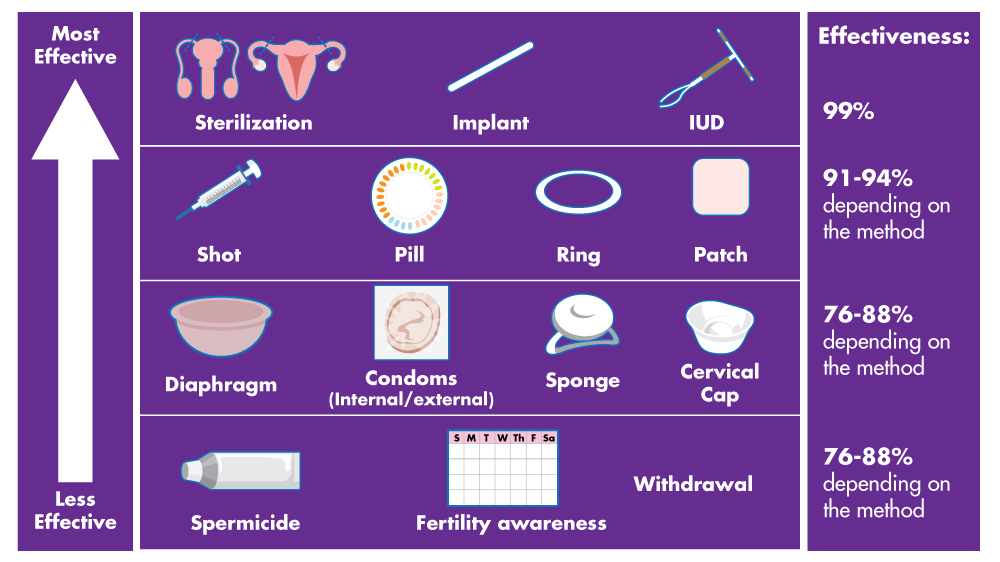Birth Control Pills
Birth control pills are composed of hormones that prevent pregnancy. The pills must be taken daily.
Pros: Has other benefits for some women besides contraception. It can reduce menstrual cramps, lighten periods, and offer some protection against pelvic inflammatory disease.
Cons: Pill has to be taken every day at the same time.
IUD
IUDs are a tiny “T-shaped” device inserted into the uterus by a health care provider to prevent pregnancy. Hormonal and non-hormonal options are available.
Pros: Long-lasting protection. Depending on the brand, IUDs can last between 3 and 12 years. IUDs are also the most effective form of emergency contraception. If you have one inserted up to 120 hours after unprotected sex, it’s over 99% effective against pregnancy. It can be removed at any time and you can get pregnant immediately after removal. Comfortable and low-maintenance.
Cons: Side effects that may last for a few days like mild pain, cramping after insertion, and others that may last for a few months like spotting and irregular periods. Needs to be inserted by a health care provider.
Vaginal Ring
A flexible plastic ring that’s inserted into your vagina and kept in place for three weeks in a row, then removed it for one week during menstruation. Three weeks in, one week out, then a new ring is inserted.
Pros: Many women have more regular, lighter periods with the ring. There’s also the added benefit of having nothing to do right before sex.
Cons: Possible side effects in the first few months like breast tenderness and bleeding between periods.
Sponge
A soft foam sponge that contains spermicide that’s inserted into the vagina to prevent pregnancy. It can be worn for up to 30 hours after it’s put in. During that time, you can have intercourse multiple times without touching the sponge.
Pros: Convenient and simple.
Cons: Difficult for some women to insert and remove. Can cause irritation.
Shot
The birth control shot is a hormone injection that prevents pregnancy for three months.
Pros: Effective, long-lasting form of birth control. Nothing to do right before sex.
Cons: Must get the shot regularly every 12 weeks. Side effects that alter period regularity.
Implant
The birth control is a thin plastic implant about the size of a matchstick that’s inserted under the skin of the upper arm. It remains effective for up to 4 years. The implant releases the hormone progestin to prevent pregnancy.
Pros: Gives continuous, long-lasting birth control without the need to take medicine every day or put something in place before intercourse.
Cons: Side effects related to menstruation like irregular bleeding or heavier flow. However, most women adjust quickly with few or no problems.
Diaphragm
A shallow silicon cup that’s inserted into the vagina. The diaphragm must be used in conjunction with a spermicide cream or gel. The diaphragm blocks the opening to the uterus and the spermicide stops the sperm from moving.
Pros: no effect on natural hormones, can be carried discreetly in purse or pocket, immediately effective and reversible.
Cons: may be difficult for some women to insert, can be nudged out of place in some situations, must be inserted every time a woman has vaginal intercourse
Sterilization
Tubal sterilization is a surgery for women that permanently prevents pregnancy. During the procedure, a woman’s fallopian tubes are closed so that eggs can’t ever reach the uterus from the ovaries.
Pros: Very effective against pregnancy. One time decision provides protection against pregnancy forever.
Cons: Minor surgery, can be expensive, from $1,000-$2,500, permanent. Reversing sterilization is very complicated, expensive, and not possible in many cases.
While all of these methods work to prevent pregnancy, they do nothing to prevent STI infection. Condoms should be combined with the preferred birth control method for protection against STIs.
Are you interested in Women’s Health and Contraception research studies? Contact Segal Institute at 1-877-SEGAL-88 to see if you if you qualify! OR fill out the form below.
Infographic source: UC Davis
Source: Planned Parenthood
[gravityform id=”3″ title=”true” description=”true”]


